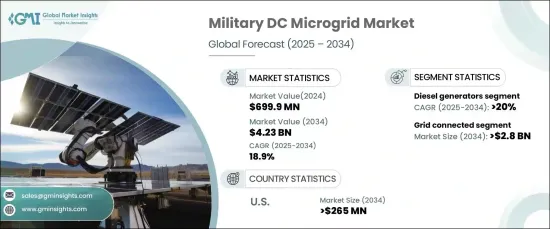
|
시장보고서
상품코드
1665320
군용 DC 마이크로그리드 시장 : 시장 기회, 성장 촉진요인, 산업 동향 분석, 예측(2025-2034년)Military DC Microgrid Market Opportunity, Growth Drivers, Industry Trend Analysis, and Forecast 2025 - 2034 |
||||||
세계의 군용 DC 마이크로그리드 시장은 2024년에는 6억 9,990만 달러에 달한 것으로 평가되었고, 2025년부터 2034년까지 18.9%라는 경이적인 CAGR로 성장할 것으로 전망되고 있습니다. 이 최첨단 에너지 시스템은 군사 용도를 위해 특별히 설계되었으며 안전하고 신뢰성 있고 탄력적인 전력 솔루션을 제공합니다. 직류(DC) 배전을 활용하여 군용 마이크로그리드는 신재생 에너지원, 첨단 에너지 저장 시스템, 첨단 제어 기술의 원활한 통합을 가능하게 합니다. 이러한 마이크로그리드는 독립적으로 작동하거나 메인 그리드에 연결할 수 있으며, 가장 원격지나 과제가 많은 환경에서도 중단 없는 전원 공급을 보장합니다.

실시간 에너지 관리 솔루션, 스마트 그리드, AI를 활용한 분석 등 DC 마이크로그리드 시스템의 기술적 진보는 시스템 효율성과 확장성을 크게 향상시키고 시장 성장을 가속하고 있습니다. 가혹한 조건에서 미션 크리티컬한 운영을 지원하는 비용 효율적이고 신뢰할 수 있는 전력 솔루션에 대한 수요 증가는 DC 마이크로그리드의 채택을 더욱 가속화하고 있습니다. 최신 제어 시스템과 신재생 에너지 기술을 통합함으로써 군사 시설은 더 높은 에너지 독립성과 운영 회복력을 실현하고 있습니다.
| 시장 범위 | |
|---|---|
| 시작 연도 | 2024년 |
| 예측 연도 | 2025-2034년 |
| 시작 금액 | 6억 9,990만 달러 |
| 예측 금액 | 42억 3,000만 달러 |
| CAGR | 18.9% |
군용 DC 마이크로그리드 시장의 그리드 연결 부문은 2034년까지 28억 달러의 매출이 예상됩니다. 그리드 연결 마이크로그리드는 지속적이고 신뢰할 수 있는 전력을 공급할 수 있기 때문에 기존의 전력 인프라가 신뢰할 수 없거나 취약할 수 있는 원격지 군사 거점에 이상적인 솔루션입니다. 임무에 맞는 조정을 지원할 수 있는 확장성과 적응력 있는 에너지 솔루션에 대한 요구가 증가함에 따라 그리드 연결 마이크로그리드에 대한 수요가 증가하고 있습니다. 유연성과 신뢰성은 중단 없는 전력 공급이 미션 성공에 필수적인 환경에서 특히 가치가 있습니다.
동력원에 관해서는 디젤 발전기 부문은 2034년까지 연평균 복합 성장률(CAGR)20%라는 견조한 성장이 전망되고 있습니다. 안정적이고 신뢰할 수 있는 전력을 공급하는 것으로 알려진 디젤 발전기는 신재생 에너지 시스템과 통합되어 지속 가능하고 효율적인 군사 작전을 지원합니다. 합리적인 가격으로 신속하게 전개할 수 있는 친환경 에너지 솔루션이 중요해지면서 디젤 발전기와 결합한 태양광 발전 시스템의 채용에 박차를 가하고 있습니다. 이 하이브리드 방식은 신뢰성을 유지하면서 에너지 효율을 높이고 지속가능성 목표와 운영 요구를 모두 충족합니다.
미국의 군용 DC 마이크로그리드 시장은 2034년까지 2억 6,500만 달러를 창출할 것으로 예측됩니다. 사이버 공격, 그리드 장애, 자연재해 등의 혼란으로부터 중요한 인프라를 지키기 위해, 에너지 회복력에 대한 주목이 높아지고 있는 것이, DC 마이크로그리드의 채용을 촉진하고 있습니다. 정부 투자, 특히 미국 국방부 투자는 에너지 안보를 강화하는 광범위한 전략의 일환으로 DC 마이크로그리드 도입에 대한 노력을 강화하고 있습니다. 이러한 시스템은 군사 에너지 인프라의 현대화에 중요한 역할을 하며, 미션 크리티컬한 운영에서 신뢰성과 안정성을 보장합니다.
목차
제1장 조사 방법 및 조사 범위
- 조사 디자인
- 기본 추정 및 계산
- 예측 모델
- 1차 조사 및 검증
- 1차 정보
- 데이터 마이닝 소스
- 시장 정의
제2장 주요 요약
제3장 산업 인사이트
- 산업 생태계
- 규제 상황
- 산업에 미치는 영향요인
- 성장 촉진요인
- 산업의 잠재적 리스크 및 과제
- 성장 가능성 분석
- Porter's Five Forces 분석
- 공급기업의 협상력
- 구매자의 협상력
- 신규 참가업체의 위협
- 대체품의 위협
- PESTEL 분석
제4장 경쟁 구도
- 서문
- 전략 대시보드
- 혁신 및 지속가능성의 전망
제5장 시장 규모 및 예측 : 접속성별(2021-2034년)
- 주요 동향
- 그리드 연결
- 오프 그리드
제6장 시장 규모 및 예측 : 동력원별(2021-2034년)
- 주요 동향
- 디젤 발전기
- 천연가스
- 태양광 발전
- CHP
- 기타
제7장 시장 규모 및 예측 : 축전 디바이스별(2021-2034년)
- 주요 동향
- 리튬 이온
- 납축전지
- 플로우 배터리
- 플라이휠
- 기타
제8장 시장 규모 및 예측 : 지역별(2021-2034년)
- 주요 동향
- 북미
- 미국
- 캐나다
- 멕시코
- 유럽
- 독일
- 프랑스
- 영국
- 러시아
- 아시아태평양
- 중국
- 일본
- 한국
- 인도
- 호주
- 중동 및 아프리카
- 사우디아라비아
- 아랍에미리트(UAE)
- 남아프리카
제9장 기업 프로파일
- ARDA Power
- AEG International
- ABB
- Ameresco
- FlexGen Power Systems
- General Electric
- PG&E
- Piller Power Systems
- Saft
- Schneider Electric
- Stellar Energy
- Siemens
The Global Military DC Microgrid Market is projected to reach USD 699.9 million in 2024 and is expected to grow at an impressive CAGR of 18.9% from 2025 to 2034. These cutting-edge energy systems are specifically designed for military applications, offering secure, reliable, and resilient power solutions. By utilizing direct current (DC) power distribution, military microgrids enable seamless integration of renewable energy sources, advanced energy storage systems, and sophisticated control technologies. These microgrids can operate independently or be linked to the main grid, ensuring an uninterrupted power supply even in the most remote or challenging environments.

Technological advancements in DC microgrid systems, such as real-time energy management solutions, smart grids, and AI-powered analytics, are significantly enhancing system efficiency and scalability, driving market growth. The increasing demand for cost-effective and reliable power solutions to support mission-critical operations in extreme conditions is further accelerating the adoption of DC microgrids. By integrating modern control systems and renewable energy technologies, military installations are achieving greater energy independence and operational resilience.
| Market Scope | |
|---|---|
| Start Year | 2024 |
| Forecast Year | 2025-2034 |
| Start Value | $699.9 Million |
| Forecast Value | $4.23 Billion |
| CAGR | 18.9% |
The grid-connected segment of the military DC microgrid market is expected to generate USD 2.80 billion by 2034. The ability of grid-connected microgrids to provide continuous and reliable power makes them an ideal solution for remote military locations where traditional power infrastructure is often unreliable or vulnerable. The growing need for scalable, adaptable energy solutions capable of supporting mission-specific adjustments is increasing the demand for grid-connected microgrids. Their flexibility and reliability are particularly valuable in environments where an uninterrupted power supply is crucial for mission success.
In terms of power sources, the diesel generators segment is expected to grow at a robust CAGR of 20% through 2034. Known for providing consistent and reliable power, diesel generators, when integrated with renewable energy systems, support sustainable and efficient military operations. The rising emphasis on affordable, quickly deployable, and eco-friendly energy solutions is also driving the adoption of solar power systems in combination with diesel generators. This hybrid approach enhances energy efficiency while maintaining reliability, addressing both sustainability objectives and operational needs.
The U.S. military DC microgrid market is forecast to generate USD 265 million by 2034. Increasing attention to energy resilience to protect critical infrastructure from disruptions like cyberattacks, grid failures, or natural disasters is driving the adoption of DC microgrids. Government investments, particularly those from the U.S. Department of Defense, are reinforcing efforts to deploy DC microgrids as part of a broader strategy to boost energy security. These systems play a vital role in modernizing military energy infrastructure, ensuring reliability and stability in mission-critical operations.
Table of Contents
Chapter 1 Methodology & Scope
- 1.1 Research design
- 1.2 Base estimates & calculations
- 1.3 Forecast model
- 1.4 Primary research & validation
- 1.4.1 Primary sources
- 1.4.2 Data mining sources
- 1.5 Market definitions
Chapter 2 Executive Summary
- 2.1 Industry synopsis, 2021 – 2034
Chapter 3 Industry Insights
- 3.1 Industry ecosystem
- 3.2 Regulatory landscape
- 3.3 Industry impact forces
- 3.3.1 Growth drivers
- 3.3.2 Industry pitfalls & challenges
- 3.4 Growth potential analysis
- 3.5 Porter's analysis
- 3.5.1 Bargaining power of suppliers
- 3.5.2 Bargaining power of buyers
- 3.5.3 Threat of new entrants
- 3.5.4 Threat of substitutes
- 3.6 PESTEL analysis
Chapter 4 Competitive landscape, 2024
- 4.1 Introduction
- 4.2 Strategic dashboard
- 4.3 Innovation & sustainability landscape
Chapter 5 Market Size and Forecast, By Connectivity, 2021 – 2034 (USD Million & MW)
- 5.1 Key trends
- 5.2 Grid connected
- 5.3 Off grid
Chapter 6 Market Size and Forecast, By Power Source, 2021 – 2034 (USD Million & MW)
- 6.1 Key trends
- 6.2 Diesel generators
- 6.3 Natural gas
- 6.4 Solar PV
- 6.5 CHP
- 6.6 Others
Chapter 7 Market Size and Forecast, By Storage Device, 2021 – 2034 (USD Million & MW)
- 7.1 Key trends
- 7.2 Lithium-ion
- 7.3 Lead acid
- 7.4 Flow battery
- 7.5 Flywheels
- 7.6 Others
Chapter 8 Market Size and Forecast, By Region, 2021 – 2034 (USD Million & MW)
- 8.1 Key trends
- 8.2 North America
- 8.2.1 U.S.
- 8.2.2 Canada
- 8.2.3 Mexico
- 8.3 Europe
- 8.3.1 Germany
- 8.3.2 France
- 8.3.3 UK
- 8.3.4 Russia
- 8.4 Asia Pacific
- 8.4.1 China
- 8.4.2 Japan
- 8.4.3 South Korea
- 8.4.4 India
- 8.4.5 Australia
- 8.5 Middle East and Africa
- 8.5.1 Saudi Arabia
- 8.5.2 UAE
- 8.5.3 South Africa
Chapter 9 Company Profiles
- 9.1 ARDA Power
- 9.2 AEG International
- 9.3 ABB
- 9.4 Ameresco
- 9.5 FlexGen Power Systems
- 9.6 General Electric
- 9.7 PG&E
- 9.8 Piller Power Systems
- 9.9 Saft
- 9.10 Schneider Electric
- 9.11 Stellar Energy
- 9.12 Siemens














